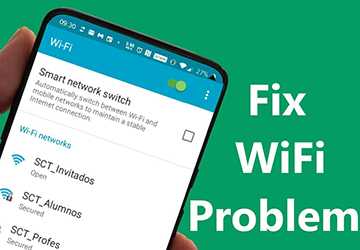7 Quick Fixes for Wi-Fi Connectivity Problems
Connectivity is crucial these days. We rely heavily on Wi-Fi to work, learn, connect with others, access entertainment and more. But nothing halts productivity faster than frequent disruptions from spotty or failing Wi-Fi.
We all know the frustration of spotty Wi-Fi. When the connection freezes up, you're in the middle of a vital video call for work.

Or your favourite show stops loading halfway through an episode. Sound familiar? Wi-Fi connectivity issues can disrupt both productivity and leisure.
The good news is that many common Wi-Fi issues can be resolved quickly and painlessly without an IT degree. Simple tweaks could lead to faster speeds, expanded range, and fewer frustrations.
Read this blog post. It will uncover the top 7 quick fixes for Wi-Fi connectivity problems. So, let's dive in!
What Causes Connectivity Issues?
Before detailing handy solutions for Wi-Fi woes, let's examine a few typical culprits. Interference from neighbouring signals, outdated hardware or incorrect router settings are the root of most problems.
Microwave appliances, cordless phones, baby monitors and security cameras often emit radio frequency signals that can conflict with Wi-Fi bandwidth on the 2.4 GHz spectrum.
Physical barriers, such as thick walls or floors, limit range. Misconfigured router settings, such as incorrect passwords or network names, also hinder connections.
Identifying the obstruction is the first step toward smooth sailing in the connectivity department.
7 Quick Fixes for Wi-Fi Troubles
Now, let's explore seven ways to nip connectivity concerns in the bud. Minor tweaks for significant improvements so that Wi-Fi woes fade into the past.
1. Change the Wi-Fi Channel for Less Interference
Switching your Wi-Fi channel to a lesser-used option in the settings can drastically improve performance by reducing interference from neighbours' networks.
How to change the channel:
● Access your router admin interface via your web browser
● Go to Wi-Fi settings and locate the available channels
● Save changes
This fast adjustment clears bandwidth traffic jams that frequently plague densely populated areas.
2. Strategically Position Your Router for Expanded Coverage
Suboptimal router placement blocks signals from reaching all areas. Find a central spot without thick barriers blocking pathways to different rooms and reposition for an optimized range.
Tips for placement:
● Elevate the router off the floor on a bookcase or wall mount
● Avoid cramming behind furniture or near appliances
● Place within view from key usage areas
Give that router breathing room; your bandwidth range will thank you through expanded, consistent coverage.
3. Upgrade Outdated Router Firmware
Outdated firmware needs to catch up with evolving Wi-Fi standards. Regular router updates provide security patches and often boost connection speeds.
Updating made simple:
● Log into your router interface through a web browser
● Check the firmware version and compare hardware specs
● Follow prompts to initiate a free update
Staying current with firmware gives that ageing router an adrenaline boost.
4. Clear Out Connected Device Clutter
An overload of connected devices drains available bandwidth, slowing speeds to a crawl. Assess gadgets linked to your network and eliminate bandwidth hogs.
Reduce device overload:
● Revoke access for devices used infrequently or visitors no longer present
● Designate the 5GHz band for high-demand uses like video streaming
● Disable background app activity on mobiles to limit inadvertent Wi-Fi drainage
Pruning away bandwidth clutter lets your network breathe and function at peak efficiency.
5. Secure Your Router Connection
Outdated Wi-Fi passwords make it easy for unauthorized connections to bog things down. Update and strengthen your network credentials for protection.
Dial-up router security:
● Establish a password with maximum complexity - long with upper/lowercase, numbers and symbols
● Change default admin credentials to prevent outside access
● Update every 90 days for the most excellent security
Fortifying defences means speed sinks and moochers can't penetrate your network to decelerate connections.
6. Switch to a Dual-Band Router
Single-band routers are increasingly obsolete. Upgrade to dual or tri-band hardware to segregate traffic across 2.4GHz for range and 5GHz for speed; this prevents competing bandwidth demand from dragging down performance.

If device connectivity issues persist on the 2.4GHz band, switching gadgets to the less congested 5GHz band may help.
7. Deter Signal Blocking Objects
If positioned poorly, microwaves, aquariums, mirrors, and more can hamper Wi-Fi distribution. Scan for potential signal barriers and rearrange items or relocate routers to foster favourable pathways.
It may feel like rearranging deck chairs, but slight shifts in obstruction patterns can alleviate dead zones.
Enjoy Better Wi-Fi Connectivity Now
While this collection of quick fixes aims to smooth out Wi-Fi hassles, constant connectivity concerns may indicate more complex issues.
Feel free to consult your internet service provider or a connectivity specialist to trace the root of the problem.
Investing in the latest mesh routers with smart bandwidth allocation or extending the range with powerline network adapters or Wi-Fi repeaters may be warranted.
Leverage these tips and tricks to say goodbye to sluggish signals & temperamental tech. Here's to smooth surfing and streaming ahead!